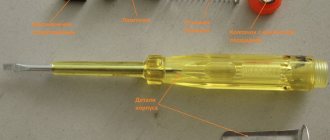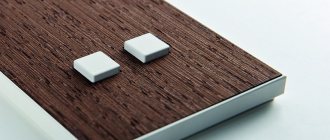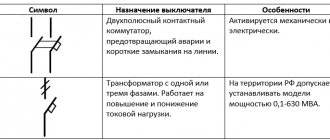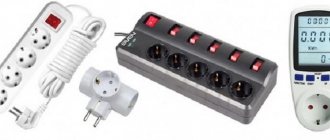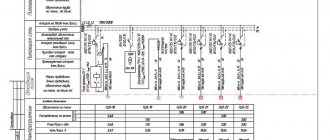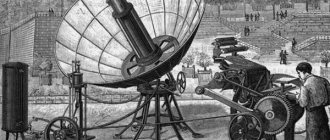Classification by type of wire/cable connection
The wire can be connected through a straight end or an end twisted into a loop.
In the latter case, the contact is more reliable, since the conductor has a larger contact area. When connecting a straight wire, it is necessary to clean its installation area with special care, since the area of contact with the contacts of the socket is much smaller. In addition, the wire can be fixed in two ways - using screws and using special clamps. Clamps are good because they allow you to install sockets faster. High-quality clamping sockets ensure good contact over a long period of time. As for traditional screw connections, they are also reliable. Their disadvantage is that they require periodic tightening - due to the loosening of the screws due to regular heating/cooling.
Sockets are often combined into modules. There are products of this type on sale with holes for parallel connection to the electrical network.
Design features
- tinned brass - for conditions with high humidity;
- brass - used in buildings with normal humidity;
- bronze - universal options.
The most capricious are considered to be white brass contacts, devoid of sputtering. With regular exposure to moisture, oxidation occurs, which leads to deterioration in quality. This drawback is eliminated with the help of special spring petals that support the contacting plates.
Tinned brass has a matte white tint, holds its shape longer, has good springiness, and has a protective coating. Similar contacts are present in sockets, which are often installed outdoors.
Sockets supplemented with bronze elements are used the least often; their distinguishing feature is their high cost. Such products have a matte yellow color. The main characteristic of bronze products is to create high-quality contact for a long time; they spring well.
Classification by contact type:
1.1 With bronze contacts
These products belong to a high price category. The contacts have a dark yellow matte tint. They spring very well, are characterized by increased strength and resistance to oxidation. Such sockets are suitable for any operating conditions.
1.2 With brass contacts
Socket with brass contacts
Such contacts are equipped with sockets of a low price category. Brass does not undergo tinning. It is easily identified by its bright shine and light yellow tint. The metal is soft and therefore quickly bends when the socket is used frequently. This leads to deterioration of the contact connection.
More expensive sockets equipped with special pressure springs do not have this drawback. Plain brass quickly becomes coated with oxides when exposed to constant/regular high humidity.
1.3 With tinned brass contacts
Tinned brass contacts are most often used in sockets in the middle price category. They have a specific whitish matte tint. They retain their shape for a long time and spring well. Due to the presence of a protective layer, they oxidize more slowly than plain brass. This type of sockets can be used when installing electrical wiring in facilities with a humid microclimate and for outdoor installation.
Types of sockets
There are several different plug and socket standards around the world.
- Type A is the American type. It is also widespread in Japan.
- Type B – Also the American version, here we are talking about a grounded outlet.
- C is the European standard. Sockets of this type are common in the territory of the former Soviet Union.
- D – British variety of plugs and sockets.
- In France, standard E is used.
- Type F is also a European standard. Here we are talking about grounded outlets.
- In Israel the type used
- I – I – Australian sockets.
- In Switzerland the standard is the type
- K refers to Denmark.
Classification by tightness and degree of protection
This parameter allows you to select an outlet for rooms with high humidity and dust. In a living room, installing a conventional device is suitable, and for a corridor - with a dust protection mechanism.
Typically sockets contain two types of markings:
- IP;
- NEMA/UL.
The first shows the level of protection from dust, moisture, and large particles. The second tells under what conditions a particular device is used.
There are 9 levels of moisture protection, indicated by numbers:
- 0—no protection.
- 1 - the device will not be damaged by vertical drops.
- 2 - protected from vertical water particles and those falling at a slight angle.
- 3 - short circuit is prevented even if the drops fall at an angle of 60°.
- 4 - the socket is not afraid of any splashes.
- 5 - the structure is protected from water jets from different directions.
- 6 - there is protection even from sea waves.
- 7 - for a short period of time the socket operates under water at a depth of maximum 1 m.
- 8 - the device can be immersed to a depth of more than 1 m.
- 9 - the socket will work during any dive.
If we talk about the second type of marking, NEMA, there are 11 types:
- Suitable for use at home or in office buildings. Protected from dust and touch.
- Usually used as household. Withstands conditions with low levels of humidity and dust.
- Recommended for use outside the home. Not afraid of icing, precipitation, dust.
- Like the previous type, it works great at low temperatures.
- It even copes with ice and wet snow. Weather conditions do not affect the functionality of the device in any way.
- It is used in dusty places located near highways. Sockets of this type are protected from dirt and water flying from under the wheels.
- Can be installed outside the building even in conditions of heavy rain or snow, wind, or dust.
- The completely closed housing allows you to use the device even under water, albeit for a short period of time.
- This type of sockets is not used in domestic conditions. Suitable for aggressive environments only.
- Used indoors. Protected from dust, dirt and liquids.
- Designed for installation inside a building. They have almost all types of protection: from dirt, oily liquids, water, coolants.
There are other classification systems and, as a result, labeling. For example, in terms of the strength of the case.
Which smart plug to buy
The variety of commercially available smart sockets can be divided into two main types according to the installation method:
- Built-in sockets are placed inside the wall, so their housing does not protrude above the surface.
- Overlays - mounted on the surface itself. They are more susceptible to damage, but are often used for decorative purposes or in areas with high humidity.
Since sockets are used constantly and quite intensively, they require a high degree of reliability. Low-quality models or fakes are characterized by mediocre assembly, cheap materials with a pungent odor and poor appearance of the contacts. It is better to refrain from purchasing such devices, no matter how cheap they are.
For the bathroom, you should choose sockets with good protection from moisture. A smart option is built-in sockets with IP44 protection or higher. For safety, bathroom models must be grounded.
Before purchasing sockets for the kitchen, you should consider their future location so that you do not have to buy extension cords. They are also required to be protected from dust and contamination.
Sockets for a washing machine, electric stove or other powerful equipment must have a thick copper cable.
Bedrooms are a great place for smart plugs that offer maximum usability. They can be turned off or on at user-specified times.
You can place an overhead socket on the balcony to avoid unnecessary manipulations with electrical wiring. It is desirable that the model has dust protection and a light indicator for the dark.
If there is a TV or computer in the room, you can install sockets specifically for the Internet connection or connecting a display. The selection of an Internet outlet is made taking into account the type of cable used by the provider.
Criteria for classifying rosettes
All sockets can be divided into several classes according to the following criteria:
- Type accepted for operation within the country;
- Method of ensuring security;
- Installation method;
- Additional features.
Based on these criteria, we can distinguish over 20 types of electrical outlets that are found in everyday life. Modern models not only provide a strong plug connection, but are also multifunctional. They are also distinguished by high safety indicators.
Types of sockets used in Russia
The following types of electrical outlets are widely used within our country:
- Invoices;
- Built-in.
There are separate sockets designed for connecting electric stoves to the network.
Invoices
They are also external electrical sockets (open type). There is no need to make a hole in the wall to install them. They are simply attached to its surface: the box protrudes strongly. The socket connector is surrounded on all sides by a protective housing. Therefore, the contacts are completely isolated from the external environment. This is one of the main differences from built-in sockets.
Built-in
They are internal (closed type). This is the name given to those sockets whose socket and contacts cut into the wall. Therefore, the body merges with its plane without forming a protrusion. They are mounted in special boxes if the house has hidden wiring. A variation is a hidden wiring socket with grounding .
For electric stoves
An electric stove is a high-power device. Therefore, it should be connected to special sockets for an electric stove. They are single-phase and three-phase, open and closed. The socket for an electric stove is 220V single-phase, and 380V is three-phase. They are capable of operating from a network with a current strength of 20 to 32 amperes.
For additional safety, the socket housing is made of refractory plastic or ceramic. And the contact group is brass.
Types of safety sockets
If the outlet contacts are left exposed, there is a risk of electric shock. This is especially dangerous for children as their small fingers can easily fit into the connector. Fidgets can also try to connect electrical appliances on their own, or poke various metal objects inside. The outlets themselves also need protection. For example, from water ingress.
With grounding
This type of socket is designed exclusively for three-phase wiring and is ideal for houses with grounding. They are characterized by high safety indicators that meet generally accepted standards.
Grounded electrical outlets have a cylindrical recess in the middle. In the recess you can find special holes intended for a fork. And in the side part the direct grounding contacts are clearly visible. The socket design is such that when connecting the plug, contact with ground is first ensured. The power contacts are connected only after this.
With residual current device (RCD)
The design of such models provides for the presence of a protective shutdown device. They are designed to ensure safety in rooms with high air humidity. For example, in the bathroom it is easy to get electrocuted when using electrical appliances if they come into contact with water. If you install a socket with an RCD, the built-in sensor will instantly detect a current leak, if any. In this case, the electrical device spontaneously turns off before the current has time to reach the person. De-energization will also occur if the insulation is broken, or if there is a short circuit.
With curtains
The simplest way to protect children from electric shock is to use sockets with curtains. They cover the connector from the penetration of foreign objects. The curtains can be opened in three ways: by pressing with force, by turning the fork in a circle, or by moving upward. Safety indicators are not the highest. However, this is better than no protection at all.
With swivel fork
The socket with a rotating plug provides excellent protection against electric shock. Its design is such that in order to close the current-carrying parts, it is necessary not only to insert the plug into the socket, but also to turn it clockwise. To turn off the electrical appliance, you will need to turn it in the opposite direction. Only then can the plug be easily removed from the socket.
With lids
For the bathroom it is convenient to use sockets with covers. Such models are reliably protected from water. If the household appliance is connected to the network, then splashes cannot get inside the socket, since they are blocked by the plug. When the device is disconnected, the socket is closed with a special cover.
By installation method
Several sockets can be installed in one block. Sometimes switches are combined with them. And the box can be mounted both in the wall and in the floor.
Wall mounted
Traditionally, sockets are built into the wall or mounted on its surface. It's simple and accessible.
Floor-standing
The wall mounting method has a number of disadvantages. This does not add attractiveness to the interior, and wires from electrical appliances can stretch throughout the room. This is especially inconvenient in offices, where employees simultaneously work with dozens of computers connected to the network.
The problem was solved by floor electrical sockets, which are mounted into the floor using a special hatch. Its lid reliably protects the nests from water and foreign objects. The hatches are level with the floor and can have a decor that is in harmony with the main design idea.
Combined with each other, with a switch
If you plan to install two or more sockets, then combining them in one block will be a rational solution. If there are only two of them, then it is possible to use only one socket box for these purposes. If their number is three or more, then they will have to be mounted in a row. For a hidden type of wiring, you will need an additional frame that visually unites the socket blocks together into a single whole. In the same way, you can combine a socket with a switch.
Smart plugs
Special smart sockets have been developed for a smart home. They are equipped with a variety of gadgets and can be controlled remotely.
With temperature sensor
A socket with a built-in temperature sensor allows you to control the temperature in the room in which it is installed. Moreover, data on air temperature can be obtained remotely via SMS messages.
With timer
An outlet box with a built-in mechanical timer allows you to set the time to turn off the electrical appliance. It will turn off on its own; your presence is not required for this. A mechanical timer allows you to set a program for turning on and off an electrical appliance for 24 hours. A box with a built-in digital timer allows you to schedule the operating hours of the outlet for a week in advance. You can read more about sockets with a timer here.
Radio controlled
Using the remote control, you can control the operation of household electrical appliances connected to the network through sockets mounted in hard-to-reach places: behind the sofa, closet, in the hallway or in the attic. Remote control allows you to turn on and off the heating or irrigation system, lighting, boiler at a distance of up to 25 meters.
Types of socket connectors
Depending on the country in which certain standards are legislated, sockets differ in the number of contact elements, as well as their shapes and sizes. Moreover, each device has a letter designation approved at the end of the last century by the US Department of Commerce. The classification proposed by the Americans was approved by other countries, and is currently valid throughout the world:
Type A
A is a standard that was once widespread throughout North America. Following the USA, it began to be used in 38 countries. This type consists of two ungrounded flat contacts arranged in parallel. A grounding element is not provided in this case. Today, such devices can still be seen in many older buildings, since they are all compatible with the modern type of plugs. The Japanese standard has certain differences, providing additional requirements for the parameters of product housings.
Type B
B - an improved version of the American standard, supplemented at the bottom of the structure with a long round contact that provides grounding. In addition to the United States, these types of electrical outlets are used in Canada and Mexico. They are also found in several South American countries, including Colombia, Ecuador and Venezuela.
Type C
C is the most common standard in Europe. The so-called Euro socket, consisting of two round contacts, is used, among other things, in the CIS, as well as in the Middle East and most countries of the African continent. There is no grounding in this design. In the Russian Federation, the dimensions and safety requirements for such products are determined by GOST 7396.
Type D
D is an outdated standard previously used by the British in territories that belonged to the British Empire. At the moment, sockets with three round contacts located at the vertices of a triangle are mainly used in India, and are also found in old houses in other countries, where the British once had a hand in arranging power supply lines.
Type E
E is a modern French standard, differing from type C by the presence of a grounding contact, which is located at the top of the device. Similar electrical network elements are also used in Belgium and Poland. At one time they were introduced into the territory of the former Czechoslovakia.
Type F
F - European standard in the form of a design of two round contacts, complemented by grounding brackets at the top and bottom. Initially, such devices appeared in Germany and began to be used for alternating current. These types of sockets and plugs are also called "Schuko", which is an abbreviation for the German Schutzkontakt, literally translated meaning "safety contact". The products are fully compatible with Russian and Soviet-made plugs.
Type G
G is a British standard that requires a fuse located inside the plug. The device consists of three flat contacts, two of which are located at the bottom and one at the top. It is possible to connect Euro plugs using a special adapter, which must also have a built-in fuse. This type of electrical network elements is supported in Ireland, as well as in the territories of some states that were once British colonies.
Type H
H is the Israeli standard, which consists of three round contacts (until 1989, flat elements were used), forming the Latin letter Y with its arrangement. This type of connection to the electrical network is unique because it is used exclusively in Israel. Other types of sockets and plugs are absolutely incompatible with it.
Type I
I is a standard common in Australia and New Zealand. Two flat contacts are installed at an angle. The third is located vertically at the bottom and is a grounding element. Similar types of electrical outlets are used in Papua New Guinea, as well as in the Republic of Fiji Islands.
Type J
J is a Swiss standard that has some similarities with type C, but differs in the presence of a grounding contact set to the side. When connecting Euro plugs there is no need to use adapters.
Type K
K is a Danish standard, the only difference from the French type is the location of the grounding contact, installed directly in the plug, and not in the socket structure.
Type L
L is an Italian standard, suggesting compatibility with type C Euro plugs. The design consists of three round contacts forming a horizontal row.
In some cases, older British designs still used in South Africa may be designated with the letter M.
Other types of sockets
Among other diversity, the following types of electrical outlets can be distinguished:
- With indicator light . When the electrical appliance is connected, the light is on. And it does not light up if the network is de-energized.
- With a screw clamp providing a strong connection between the socket contacts and the wiring. During installation, the installer places the wires between two plates, which are firmly clamped with a screw.
- Pneumatic sockets are socket devices with an operating voltage of only 24 Volts. It is not a plug that is connected to them, but a cleaning hose. Essentially, this is a built-in vacuum cleaner that doesn’t require any space in the house. And there is no need to periodically empty the container of garbage. Pneumatic inlets are wall-mounted and floor-mounted.
- A pass-through electrical socket is not the end point in the electrical circuit. The power wire feeding it goes to the next one. There may be several sockets connected in series in a circuit.
- Universal are sockets with a large number of types of connectors. Adapters are often included in the kit. This is very convenient when you have to use electrical appliances with different types of plugs in your home.
Classification by type of installation
There are three types of sockets based on the type of installation: external (external), internal (hidden) and retractable. External models are fixed directly to the wall plane. When installing on fire-hazardous surfaces, it is recommended to additionally use dielectric plates. They are sold in stores, but they are easy to make with your own hands - just cut a square or circle of the required size from textolite, asbestos-cement board, etc.
External
devices have two advantages. This is a quick installation and easy replacement (if necessary). Their disadvantage is that they look unaesthetic and often “spoil” the interior. In addition, protruding overhead products can be “caught” or accidentally hit with a heavy object, which often leads to the breakdown of such sockets.
Example of an external socket with four sockets
Internal
Models are more difficult to install. They are inserted into the so-called “glasses” (socket boxes), which must be mounted into the wall. In the case of concrete and brick surfaces, you will need a hammer drill for these purposes. But hidden sockets look aesthetically pleasing. Their front panel is completely recessed into the wall, or protrudes outward by only a few millimeters.
Example of an internal (built-in) socketRetractable
models are expensive. They are practical and functional. Most often used in arranging kitchen premises. Such sockets are built into countertops, side panels of cabinets, etc. They are even mounted inside floors. All that reminds you of the presence of an outlet is a neat cover, under which the outlet blocks are “hidden” for convenient connection of any equipment.
The photos above show an example of retractable sockets
Installation work
An internal socket is also called a single socket. Its installation is easy to do with your own hands. To do this, you will need a hammer drill, with which you prepare grooves in the wall and a hole for the socket box. If installation work is carried out in a house with electrical wiring, it is recommended to turn off the circuit breaker in the distribution panel.
Then check the presence of current at the installation site of the socket. An indicator screwdriver is used for this. To recess the connector into the wall, a plastic box is mounted. Experts advise giving preference to boxes that meet the new standards.
Metal socket boxes are current conductors that are poorly fixed. This can subsequently lead to loosening of the housing and breakage. Installing a plastic box in a load-bearing wall requires the use of alabaster. The groove is first moistened with water, then the box is fixed with an alabaster solution.
If you replace the mixture with self-tapping screws, the reliability of the installation may suffer. At the end of the installation work, it is necessary to insert electrical conductors under the socket. The next step is to install the housing. To do this, strip the electrical wires of insulation with a knife. The contacts are fixed in the housing.
To secure the structure, you will need 5 screws:
- lateral ones - for spacers of the legs;
- in the center - for grounding;
- right and left - for phase/zero.
Loosen the 3 central screws, inserting the exposed wires, tightening with a screwdriver. The phase is connected to the hole on the left, and the zero is connected to the hole on the right. The device is fixed in the socket box. The legs must be opened using the side screws.
To ensure reliable fastening, when choosing connectors, it is better to give preference to products with claws and 2 teeth. The legs are replaced with an overhead housing, which is fixed on both sides with self-tapping screws. Then the device is “hidden” in the wall using decorative edging, tightening the screws until they stop. The wires must be tightened well, otherwise the gradual melting of the housing caused by heating will lead to a fire.
Installation of triple devices
To mount a triple socket, the location of the component elements of the device on the same level is taken into account. Particular attention is paid to safety, since the electrical wiring will be subject to a triple load. According to the standard, connectors are mounted from the floor at a height of more than 25 cm.
Installation is carried out in the locations of single-type devices. Installation in a new location is allowed . To do this, perform the following steps:
- Marking. Using a building level, draw a horizontal line and mark the centers of the sockets, taking into account the distance between them. In this case, from the center of the first connector, measure ½ of the width of the cover designed for the socket box. In a similar way, determine the center of the remaining rosettes.
- Installation of a socket box. For triple sockets, choose a single box. It is presented in the form of a block with three sockets located on one frame. If you are installing 3 separate sockets using a parallel connection, it is better to install single boxes. Their installation is identical to the installation of similar models for a single socket.
- Wiring. To connect a triple device, 2 wires from the cores are supplied from the panel to each wiring, which will fit into 2 and 3 sockets. Using an indicator screwdriver, zero and phase are determined. Power is turned off. The wires are twisted by screwing them.
- After the first twist, the wires are thrown onto the second device. The procedure is performed through the back cover, inserting the wire into the box. Work with the third socket using a similar scheme.
- Fixation of socket boxes. The holes in the wall are lubricated with alabaster solution. The boxes are put into place. If they fall through, add solution, and if they bulge, tap with a hammer.
- Connecting sockets. The wires are connected to the appropriate terminals, pressed tightly with screws or terminals. They are twisted inside the box, mounting the central part. To level the entire structure, tap the body. Then decorative overlays are installed.
You might be interested in this: How to connect a generator to the network at home
If the installation is completed, the machine turns on. To check the functionality of the sockets, connect the plug of the table lamp. 4-way connectors are installed using a similar scheme. If the sockets are connected in series, a loop is used. Such devices are not recommended for use with devices that consume significant amounts of electricity.
Plasterboard walls
In closed buildings for various purposes, interior partitions can be made of plasterboard. It's easy to hide sockets under it. But since drywall is considered a flammable material, boxes for connectors are selected according to fire safety rules.
Experts advise buying devices made of self-extinguishing plastic. The socket boxes must have special fasteners that ensure maximum fixation of the devices to the drywall. Installation work begins with making holes in the drywall.
To do this you will need a matching crown. It is selected taking into account the external parameters of the box. Before drilling, check the presence or absence of a profile using a regular magnet. Wires are pulled through the hole, which must be passed into the box from the outlet.
The device will need to be recessed into the hole, clamped with fasteners. Additional fastening is provided by the solution. Then the electrical cable is connected and the core is installed. Installation of connectors can be carried out using different methods. But they all ensure the safest and most uninterrupted operation of the devices.
Types of electrical outlets
How to choose a socket? Typically, sockets are produced with grounding or without grounding (Fig. 1), which are selected in accordance with technical conditions. For example, in kitchens or bathrooms where powerful equipment is installed, sockets must be grounded, including those used for the hob.
For rooms with high humidity, it is better to choose sockets equipped with covers (Fig. 2). They are installed in swimming pools, bathrooms or outdoors, as is often the case in private homes. The protective cover covers the socket and is an effective barrier to moisture penetration. In addition, such products have an additional degree of protection.
In many cases, it is much more convenient to use double sockets (Fig. 3), installed in a common mounting box
When purchasing, you should pay attention to the quality of the internal elements, since such products are often subject to double loads
In children's rooms, sockets are installed, equipped with a special valve or protective curtains (Fig. 4). Thus, the device is protected from children's pranks and opens only under the influence of an electric plug. Another type of socket has a push-out function (Fig. 5), allowing the plug to be easily removed. The wire is additionally protected from damage, which is especially important when household appliances are frequently changed.
The so-called smart sockets (Fig. 6) are equipped with a timer that turns off at a set time. In this case, the plug remains plugged into the device, but turns out to be de-energized.
There are other types of sockets used in low-current networks. Computers, telephones, antennas, radio points, etc. are connected to them. Some designs are equipped with several connectors at once. In private homes, power sockets can be installed for connecting electric motors, welding and other powerful equipment.
Classification of plug sockets
Since the state standards of different countries provide for different parameters of the electrical network and requirements for the design of electrical installations, it is quite natural that there are a large number of very different electrical outlets, the differences of which are in the value of their rated voltage and current, the number of pins, overall dimensions, methods of polarization, etc. d.
In our country, as well as in many European and Asian countries, electricity is used with a voltage of 230 V and a frequency of 50 Hz. Therefore, it makes sense to consider only those sockets that are used in such electrical networks.
According to the international classification, sockets that can be used in our country belong to two types:
- Type F or CEE 7/4 “Schuko” with grounding (according to GOST 7396.1-89 it belongs to type C2).
- Type C without grounding. (according to GOST 7396.1-89 it belongs to type C1-a).
The following types of sockets are distinguished:
- According to the method of mounting to the wall: for use in open or hidden wiring. Portable sockets can be divided into a separate group.
There are overhead and built-in (flat) sockets. As a rule, overhead models are used when installing open wiring. Their main advantage is the extreme ease of installation. In order to install such a device, there is no need to drill a hole for the socket box, but rather just secure the block to the wall using two screws. In wooden houses, this installation option is almost the only one, since it fully complies with the requirements of fire safety regulations.
Surface-mounted sockets can also be used as temporary devices in cases where it is necessary to quickly replace a faulty one or install a new point for connecting electrical appliances to the network, and it is impractical to carry out significant repair work.
The advantages of built-in socket models include their more attractive appearance than their overhead counterparts, as well as reliable fastening and a high degree of protection against electric shock. Such protection is achieved by the fact that all current-carrying parts are located deep in the wall, the decorative part practically does not protrude beyond its limits, which reliably protects the device from various, including unintentional, mechanical influences.
- By current value.
Almost all modern electrical outlets are designed for currents of 6, 10 and 16 A. This is significantly more than the indicators of old Soviet models, whose rated current was 6.3 A.
USEFUL INFORMATION: Types of batteries: choosing a heating radiator for an apartment
To connect particularly powerful consumers, such as hobs, air conditioners or boilers, you should use special devices that are highly resistant to high currents. In addition, all of them must have a contact for connecting protective grounding. However, such equipment, as a rule, is installed permanently and cannot be moved around the apartment. Therefore, in many cases, to increase the reliability of electrical connections when connecting powerful consumers, sockets are not used at all. The wire through which the electrical appliance is powered is led directly to the electrical panel when entering the apartment and is connected to it through a separate circuit breaker of the appropriate power.
In order to determine the permissible power of a consumer that can be connected to the electrical network through an outlet, it is necessary to multiply the values of the maximum current and voltage of the network.
Thus:
P = U*Imax = 220*10 = 2200 W, or P = U*Imax = 220*16 = 3520 W.
It should be noted here that when using most models of splitters, the total permissible power of electrical appliances connected to the outlet is significantly reduced. This happens, firstly, due to the appearance of an additional detachable connection, and secondly, due to the poor quality of the contacts of most tees and extension cords.
- By the presence of protective grounding. There are sockets that have a contact for connecting a ground wire, as well as those that do not have this contact.
Models with grounding are undoubtedly safer if it is possible to connect such a device correctly. Otherwise, there is no difference between the two types. And if the grounding wire is connected incorrectly, the risk of electric shock increases many times over.
In old apartment buildings, electrical wiring requires only two wires: neutral and phase. The neutral wire is connected to the neutral point of a three-phase electrical network, the phases of which are connected in a star configuration (only such a connection is used to power residential buildings). In addition, the neutral wire must be properly grounded. Under normal operating conditions (that is, if there are no accidents in the network and the load on each phase is approximately the same), no current flows through the neutral wire of a three-phase system and the voltage on it relative to ground is zero.
In the event of an accident (severe phase imbalance, open circuit or short circuit), situations may arise when a certain potential appears on the neutral wire in relation to the ground.
If the body of an electrical appliance, for example, a washing machine, is “grounded” to the neutral wire through an outlet, then there is a risk of electric shock to people. To prevent this phenomenon, it is best to make a separate grounding with a specially routed wire, however, in high-rise buildings this is quite difficult to do.
How to distinguish high-quality devices from low-quality ones
First of all, you should pay attention to the build quality of the product. Contact connections must be made with high quality and look reliable
The housings of sockets and switches should not be deformed, without chips or cracks. The color of the cases should be uniform, without traces of heating or darkening. Fastening elements must be included.
All products must be accompanied by a quality certificate and the corresponding IP protection system marking.
Don’t try to choose the cheapest product option. The safety of people in close proximity to the electrical device largely depends on the quality of the electrical product.
The electrical goods market is filled with many offers of electrical products. Switches and sockets are one of the most popular products in this category. In order not to get confused and make the right decision when choosing them, you must always follow the above recommendations and objectively evaluate the functional features of the required product.
Selection by manufacturer
Basically, the quality of devices is determined by their service life, reliability and ease of installation. Each company was selected for the rating presented below based on these criteria. The top ten were made up of the most popular manufacturers. They, in turn, can be divided into two subgroups including budget and high-end:
- The first subgroup included: Anam, GUSI, Makel, Lezard, Wessen, Belarusian sockets. These manufacturers know exactly which sockets would be best to install in an apartment and solve this issue through quality and moderate cost. The design of the products is quite simple and discreet, however, in terms of functional characteristics, they are standard high-quality models that can be easily installed in an apartment.
- The second group consists of premium products that amaze not only with their quality, but also with their elegance and style. These include the French Legrand, Italian Bticino and German Scneider-electric. Each of these companies demonstrates an original approach to the production of their models. They have no fundamental differences in functionality; there are only individual preferences of the client, who is ready to overpay not only for a well-known brand, but also to receive excellent quality. The collections of these manufacturers are so diverse that choosing the right option is quite difficult. There are also standard models that are not inferior in reliability and in a relatively similar price range.
First place can still be given to the French for their reasonable prices. At the same time, the colors and model range are among the most diverse. The next one is a German manufacturer that takes into account the most popular needs and implements solutions in various directions, producing high-quality sockets and switches. The Italian manufacturer, in addition to the quality of the components themselves, focuses on the originality of the appearance of the sockets, which invariably evokes a feeling of admiration among the consumer.
Unfortunately, it is not yet possible to include domestic manufacturers in the list of the best, since the performance of their products does not reach world standards. However, this does not mean that domestic sockets are of poor quality - they are simply not in the TOP ratings.
Selection by installation type
The most acceptable option for the best household outlet for an apartment is a built-in one. These sockets are designed in such a way that the electrical part is recessed into the wall. This structure allows you to save space, but it is advisable to choose the installation location in advance, even at the time of installation of the wiring. This is due to the fact that such devices are used together with wiring laid inside the wall. Such connections are the safest and highest quality during operation.
Surface-mounted sockets are screwed onto the surface - this is a good option when using open wiring on top of the wall. They are more often used as a temporary device and are somewhat inferior in safety.
type of instalation
The next type includes the type of housing that is used in the outlet. At the moment, you can find overhead sockets that are used for external wiring. You can also find recessed sockets that are suitable for hidden installation.
Today, recessed sockets can be mounted not only into the wall, but also into the floor. Below you can see what this option looks like.
Portable sockets can now be classified as a separate type of device. This is a fairly convenient option, but in Russia it has not yet gained its popularity.
Standard standards for the placement of sockets and switches in diverse residential areas
The plans for sockets and switches in a standard apartment look like this.
In the kitchen
It is worth clearly planning how many household appliances will be located in the kitchen. Of course, it is not easy to answer this question, because new electrical appliances are often purchased: a kettle, a coffee grinder. Typical equipment is: refrigerator, stove, microwave, etc.
The easiest way to determine the position of the sockets is above the tabletop - just step back 10-30 cm.
- sockets for built-in appliances - need to be placed behind the cabinet;
- for the hood – 0.6 meters from the kitchen cabinet;
- for small units - 20 centimeters from the tabletop.
Switches are most often located at the entrance to the room.
For the electric stove we install special three-phase sockets of 20-25 amperes.
In the living room
There are several options for placing electrical points in each individual zone:
- sofa area;
- doorway;
- television zone;
- Desktop.
Modern designs often seamlessly combine remote switches.
For audio and video equipment in the living room you will need several special sockets - television sockets in the first place.
In the bedroom
Switches, as a rule, are installed behind a furniture wall (“Soviet layout”). The most practical way is near the bedside tables.
The classic option for lighting the sleeping area is a block of two sockets above the bedside tables at a distance of 15 cm from their surface.
In the bathroom
All devices should be protected from liquids.
The number of sockets depends on how many electrical appliances (washing machine, hair dryer, razor) you plan to connect in the bathroom.
In the hall
Switches at the entrance are definitely needed. Several “sockets” for portable household devices.
One or two sockets in the corner above the baseboard, at a height of 30 cm from the floor, are enough.
What types of sockets and switches are there?
Both sockets and switches have many different functions depending on the product types.
Types of sockets
Before choosing a socket, first determine the appropriate type of product, taking into account that they come in the following types:
Sockets without grounding. They are used in cases where grounding is not provided or is not necessary, for example, in residential premises.
Grounded sockets
Installed in places where it is important to have grounding. Most often these are the kitchen or a socket for connecting a computer.
They are also used in private homes.
Sockets with cover. The use of such an outlet is important in rooms with high humidity, such as a bathroom, boiler room, swimming pool, or an external outlet in the house. Such products have a special cover that covers the entire area of the outlet and actively prevents the ingress of water or moisture. In addition, it is important to know that sockets for use in wet areas must have a special IP rating.
Double sockets. They are mounted in a socket box, allowing you to use two electrical connections at once. The not very reliable mechanics of such an outlet can be unsafe.
Sockets with a protective shutter or valve. Children's rooms are equipped with such sockets to prevent the possibility of plugging something thin into them. The openings of such an outlet are covered with a kind of curtain, which opens only if an electrical plug is inserted into it.
Plug-pull sockets. They are equipped with a special button, by pressing which a person can easily remove the plug from the socket. Protects the wire from damage, useful in places where equipment is frequently changed, for example, in the kitchen or hairdresser.
Sockets with shutdown timer. The timer function allows you to independently set the operating time of the outlet. It is important, if necessary, to turn off the network at night or in production at the end of the working day. Also used in combination with appliances equipped with a timer, such as an air conditioner, electric oven, multicooker or TV.
Special sockets. Designed for antennas, telephones, radio points, computers, etc. There are both built-in and overhead options. There are also types that combine several connectors at the same time.
Power connectors. Special plug connections, which are mainly used on construction sites to connect particularly high-power devices, for example, a welding machine.
Types of switches
To more clearly imagine how to choose a circuit breaker or a manual one, also initially familiarize yourself with the existing varieties provided by modern manufacturers:
- Illuminated switches. Convenient in dark rooms where you need to look for a switch in pitch darkness. Ideal for installation in hallways, kitchens and hallways. In the bedroom, this light can be disturbing.
- Switches without backlight. Universal in use.
- Lighting regulators. Used in combination with incandescent lamps to smoothly change the lighting level. There are sensory and mechanical. Not suitable for use with halogen, fluorescent and LED lamps.
- Pass-through switches. They are used where it is necessary to control different lighting groups. May have several keys. Examples of such rooms are rooms with chandeliers, in which there are several groups of lamps, or in large auditoriums.
- external wiring;
- hidden wiring.
Product types
Electrical sockets that are operated in a network with a voltage of 220 V are classified into 4 types:
- Soviet. Old style connectors that have poor contact due to the soft fit of the plug.
- European. They have a deep seat and a round hole for the plug. The downside is the tight fit, which makes it difficult to remove the fork.
- American. They have thin rectangular slots for a plate fork. Disadvantage: poor contact.
- Universal. Provides the ability to include American and European plugs. Used for imported electrical equipment.
To ensure that the process of operating high-power electrical appliances is safe for the user, experts advise purchasing sockets with a grounding contact. First you need to find out whether there is grounding in your apartment, house, or office. If the facility does not provide a 3rd wire in the wiring, there is no need for a grounding connector.
You may be interested in: Selecting a circuit breaker
To operate low-power devices, you can use a socket without grounding. Experts believe that the absence of an intentional electrical connection does not affect the protection of the device, unlike consumer safety. If the house has household appliances that consume 300 W of power, it is better to install a grounded outlet.
Internal and external electrical outlets are installed at various facilities. Built-in models are suitable for arranging hidden electrical wiring, and overhead models are suitable for external wiring. A built-in or internal socket provides for the laying and connection of wiring in the wall. It is used when arranging hidden and external wiring. Additionally, a hidden socket box is installed. Experts include retractable models in this category. They are mounted into countertops.
Surface-mounted sockets are easy to install, as they do not require installation of a socket box. They are mounted in the wall, having previously made 2 small holes in it for dowels with a plug. The disadvantage of the overhead device is the large protrusion from the wall.
Additional functionality
Considering the additional features, you can buy connectors with different capabilities on the market. The child safety socket moves to the side when pressed with a plug. The waterproof rozetka ssd is equipped with a cover. The product is installed outdoors, in the bathroom, as the cover reliably protects the contacts from water ingress.
For automatic control, there are two types of timer connectors:
- daily - programming the socket operation for 24 hours;
- weekly - programming work for a week.
To turn on/off the consumer connected to the connector, models with a switch are provided. They are characterized by a long service life. Other improvements include illuminated sockets. They serve as beacons in the dark.
Consumer power
Internal and external electrical sockets are available for special purposes. Based on this criterion, a classification of connectors has been adopted into the following types: for powerful consumers of continuous operation, as well as those mounted in a panel. The first group includes connectors into which hobs and other similar equipment can be connected. The devices consume significant power and require grounding.
The second group includes sockets that are installed in the panel on the rail. Their purpose is to connect consumers located close to electrical panels. Such connectors are considered the optimal solution for connecting powerful devices to the electrical network.
The difference between the sockets of these two groups is in the power designed to operate with a certain current strength. Therefore, the connectors are marked with one or two numbers and the letter A (current value). Household sockets are rated at 16A.
You might be interested in: Features of connecting a chandelier with 3 wires
Another classification is based on the number of consumers simultaneously connected to the connector:
- single;
- double;
- triples.
Experts distinguish between low-current sockets, which are used in everyday life separately for telephone, TV, and Internet.

